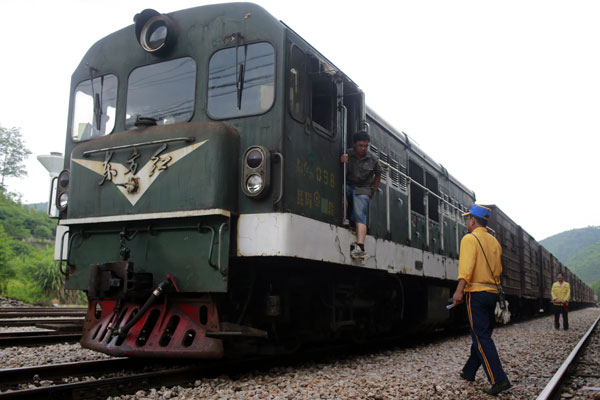Change of attitude
Li Fan, director of the freight service division at Luliang Railway Station in Kunming, visited 30 local companies during late June and July to introduce the new policies set in place after the reform and to canvass for new customers.
Because of the complicated procedures involved in rail freight, Yang Liuhua, general manager of Huasheng Flour Plant Co in Luliang county, decided to give up on the railway and use road transport, even though it costs more.
Late last month, Li paid Yang an unscheduled visit. "I couldn't believe the railway station actually sent someone to talk with me. In the past, they were the boss and I had to plead to have goods carried to the destination," said Yang.
|
 A freight train in operation in Yunnan province. Feng Yongbin / China Daily |
After two hours of discussions, Li convinced Yang to give the railway another chance by emphasizing the advantage of the lower cost, said Yang. As of July 31, the Kunming Railway Bureau had signed contracts with 12 major local companies in the iron and steel, coal and tobacco industries.
Wangjiaying West Railway Station, a transfer hub located in a suburb of Kunming, generated revenue of 790 million yuan in the period from January to July and expects revenue of 1.4 billion yuan by December, a rise of about 40 percent year-on-year, said Tang Guizhuang, the station's director.
Adhering to the reform, Tang used 15 of his 253 workers to establish a new marketing and services department to find and attract new clients. There are five ways to book the service, the two most popular being the phone and the Internet. Each member of the marketing and service department is mandated to visit and persuade a targeted company to ship its goods by rail.
Since June 15, the station has transported 18,000 tons of freight every day, a notable increase from the 1,200 tons carried during the same period last year. "The increase in cargo volume and revenue can be attributed to the reform. It made us adopt a customer-friendly model for freight transport," said Tang, who added that staff members have been instructed to accept certified goods the minute they arrive.
|
|
The changes have also seen an increasing number of non-corporate customers using the rail network to transport commodities or personal goods.
"Large-scale commodities have always been our primary business. Last year, they accounted for 90 percent of our total freight volume. However, individual items have increased since the reform and now account for 50 percent of the freight we transport. In 2012, the number was much lower, around 10 percent," said Tang.
"Private customers are usually much more concerned about when the goods will arrive, and the rising number of contracts with individuals indicates that the service is being used by new customers."
Tang is confident that the lower charges will swell customer numbers and raise transport volume, even though the station stands to lose at least 10 million yuan per annum because the per-ton service fee has been canceled at the request of the CRC.
"To put it in a very simple way, the companies used to treat us to dinner. But now, we have to invite them for dinner. The relationship has changed fundamentally as clients have become 'gods', as the market demands," said Tang.
